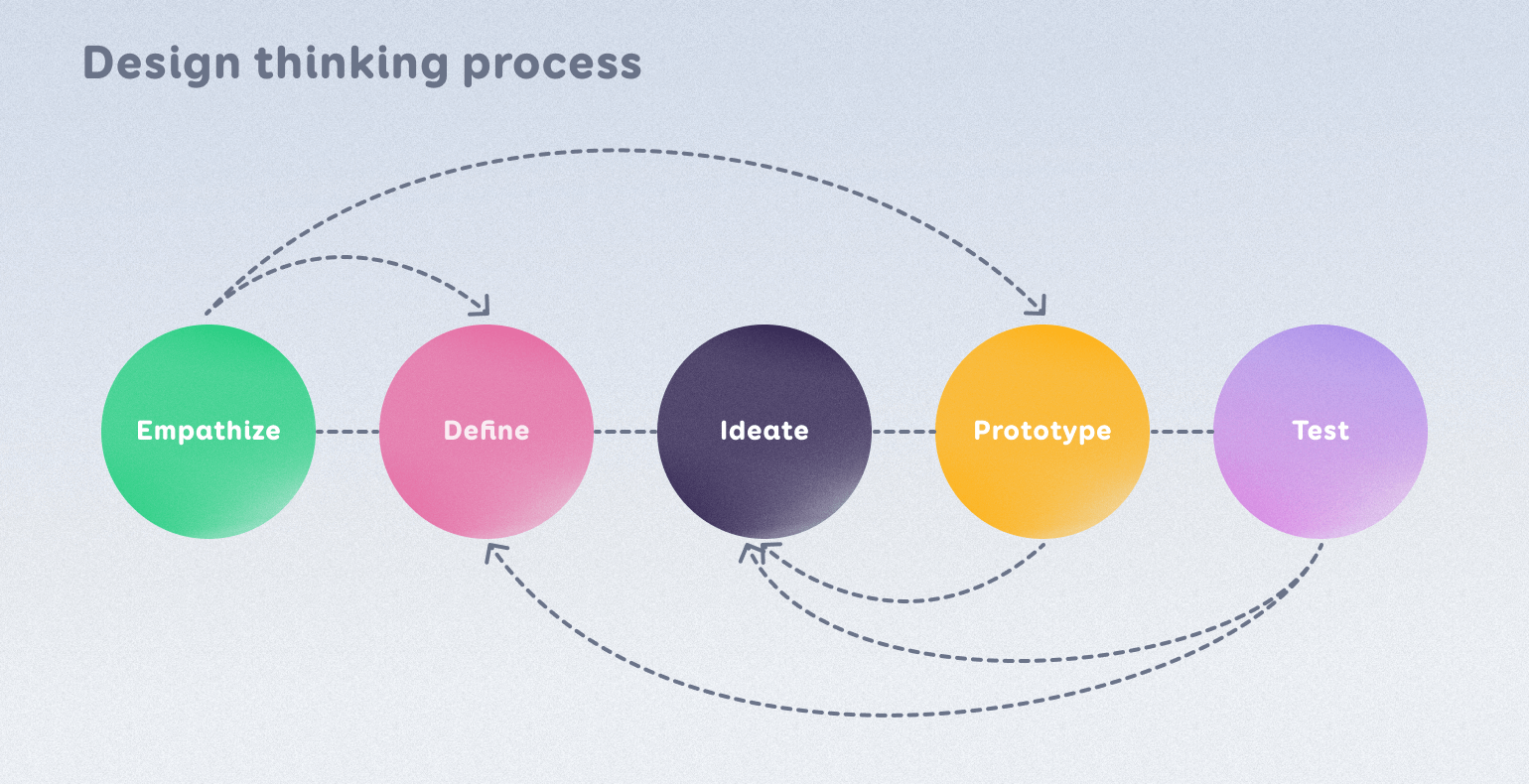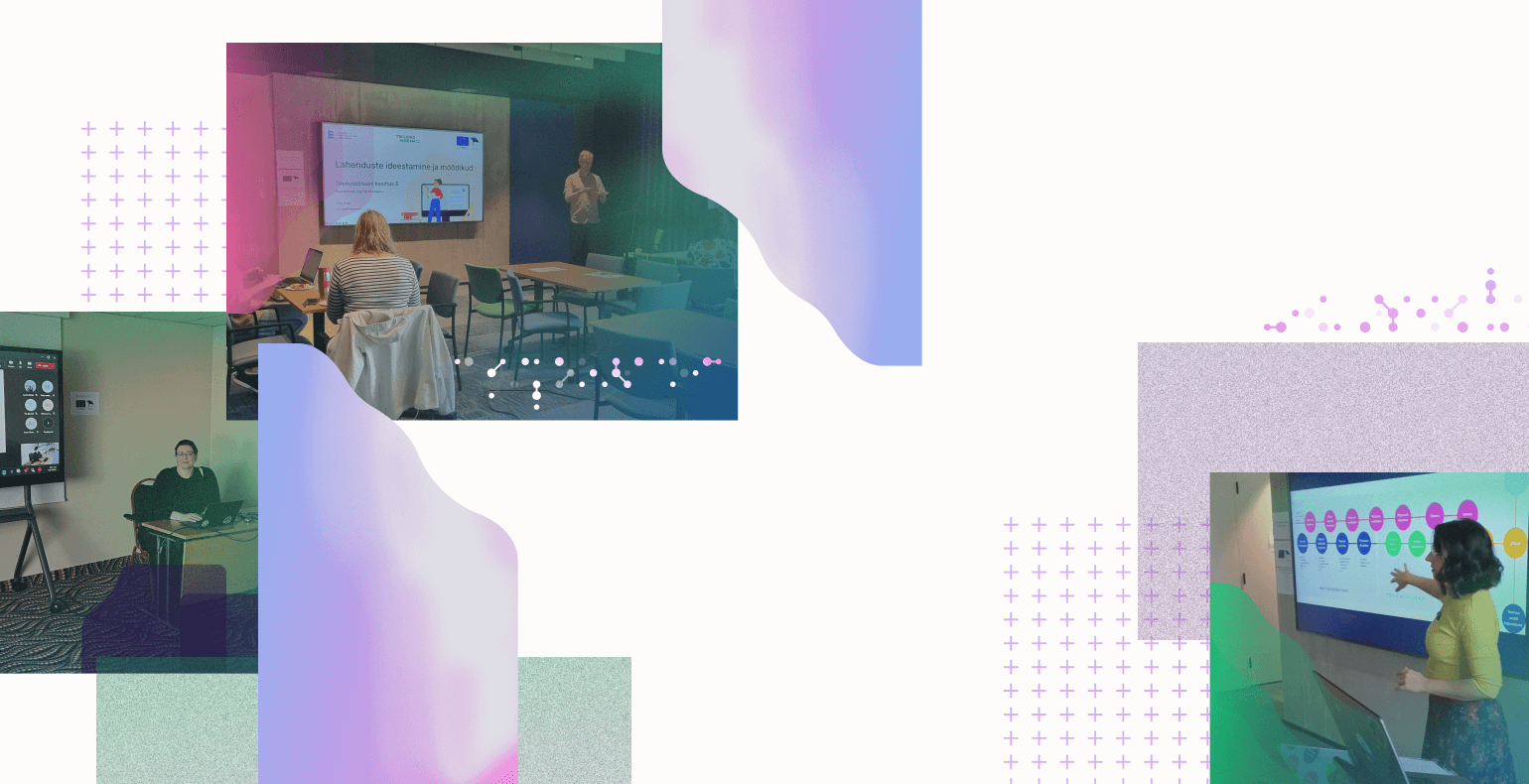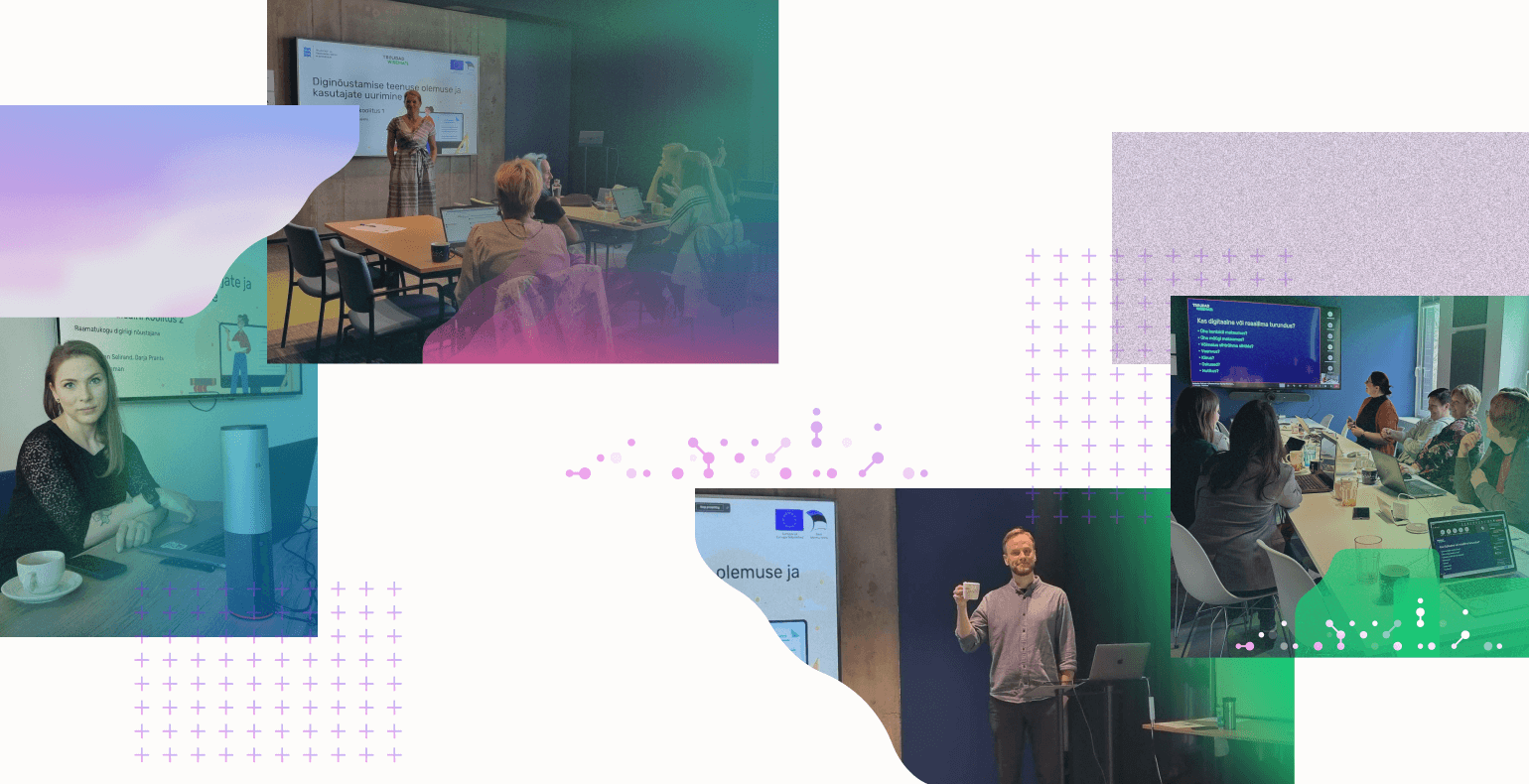Making you a Service Designer in 5 Weeks: Trinidad Wiseman's Approach to Cultivating Design Skills in Estonia
It's safe to say 2023 was a BIG YEAR OF TRAINING in the history of Trinidad Wiseman. We have had analysis, development and agile management methodologies' trainings as part of our services portfolio for a long time. However, last year, we also conducted two massive human-centred service design training programmes for the public sector (on behalf of the Ministry of Economic Affairs and Communications) and trained two groups of Estonian tourism companies in a masterclass on service design and digitalisation.
More than 400 new design-savvy people in Estonia
We are delighted to note that during this training year, more than 400 people successfully completed the training programme, including 224 librarians, nearly 100 state and local government officials, and 24 teams from the tourism sector. We believe that all these people will carry forward the human-centred design mindset in their organisations and companies achieving remarkable results through application of service design skills.
What do non-designers do at a service design training and what can they gain there?
Design thinking-based service design is nothing but customer/user-oriented planning and organising process. It is a universal methodology that encompasses best practices for analysing customers/users and designing services within the sustainable capacity of a company or organisation. The great value of learning service design lies in the fact that the acquired tools can be successfully used in other projects and situations, not just in service design.
At a service design training, learning predominantly occurs through a "hands-on" method: participants engage directly with their specific challenges or ideas. Working with real topics drives participants’ motivation and helps cement new knowledge. The extent to which the topics presented at the training are resolved is influenced by several factors: the length of the training programme, the complexity of the issues being addressed, and the dynamics and skill levels of the participating teams.
Another important aspect is the opportunity to practice teamwork during the training, as service design is a collective activity.

The benefits gained from service design training include:
- Developing a customer-centric approach: service design training helps the team to better understand the needs and wishes of clients/users, colleagues, and partners. It teaches methods and techniques for creating stronger relationships with customers as well as understanding and meeting their expectations in a better way.
- Encouraging innovation: Service design training promotes creative thinking and innovative approaches to problem-solving. Teams learn through practical exercises how to find new solutions and develop services that are beneficial and distinctive.
- Enhancing process efficiency: Service design training helps analyse and optimise a company's service delivery and other processes. This can lead to reduced costs, better resource allocation, and increased overall work efficiency.
- Improving teamwork and collaboration: Training helps teams work better together towards a common goal. Service design methods foster a multidisciplinary approach, enabling various departments and specialists to collaborate on finding solutions.
- Boosting customer satisfaction and loyalty: Higher-quality and more customer-centric services enhance customer satisfaction and loyalty. This, in turn, can lead to the formation of longer-term relationships with clients.
- Achieving competitive advantage: A company or organisation that improves its service design and optimises customer experience gains a clear competitive edge in the market.
Design Thinking: The Cornerstone of Exceptional Service Design
Design thinking (which we base both our design and development projects and training programmes on) is a problem-solving process centred around a human being with their needs, attitudes, and experiences. The process is cyclical and creative, focusing on quickly and painlessly trying out different solutions to avoid unnecessary redoing costs (inevitably associated with services developed without prior validation).
Putting the human being in the centre of design means that our solutions are tailored to fit the individual; rather than the individual having to adapt to our service. This implies that there are no 'stupid users', only poorly designed services.
The design thinking process has five stages:
- Empathy - researching user needs;
- Definition - describing user needs and problems;
- Ideation - generating solution ideas;
- Prototyping - creating quick solutions;
- Testing - validating solutions and learning from them.

Illustration: Five steps of design thinking
The same logic is also followed in the Double Diamond model (created by the UK Design Council), often used in service design. This model too describes the design process as sequential steps. However, in the Double Diamond, the process is divided into four parts, where divergent and convergent thinking alternate, so that the first diamond is dedicated to exploration and the second to design.
The Double Diamond model consists of four stages:
- Discover - creating empathy with the target group, exploring the nature of one's service and its users;
- Explore - analysing input, defining typical users, sketching the user journey, and articulating the problem for finding solutions;
- Develop - generating solutions and creating metrics;
- Deliver - formulating concrete implementation plans
for solution ideas.

Illustration: double diamond
Design principles, structured models, and methodologies are the foundation of all our service design trainings. Nothing at our training programmes occurs by chance, and every activity has a specific purpose. Improvisation is possible, but only within the framework of the process.
Training is valuable, if conducted by practitioners
While design thinking is the basis of user-centred design, our trainings focus mainly on design doing. It's guided by specialists with years of experience in various business and systems’ analysis, design, and development projects. Understanding the process from comprehending a client's business needs to delivering a final software solution is fundamental for all our specialists. We choose trainers who have completed a significant number of projects, as this experience allows them to provide participants with practical advice, guidance, recognition, or advice against risks.
At a Trinidad Wiseman training session, you can be sure that the trainers have repeatedly used the methods and tools they introduce, in client projects. We maximise knowledge transfer with examples from completed work. Our specialists also have experience in choosing the right tools for achieving certain objectives. They can also highlight potential pitfalls that may derail the design process and opportunities to try "outside-of the-box" solutions.
How design training helped to make the public sector more human-centred
One of our major training programmes last year was the "Development of Human-Centred Digital Services" for public sector employees, conducted on behalf of the Ministry of Economic Affairs and Communications. During the programme, four groups passed through the training, each consisting of teams from five different authorities.
The target audience for the training were:
- Employees of state agencies whose daily work involves development of the digital state or related fields (e.g., service owners);
- Employees of local government unit institutions whose daily work involves development of the digital state or related fields (e.g., service owners).
The goal of the training programme was to provide participants with necessary knowledge and practical skills to develop human-centred digital services. The training programme consisted of five intensive training days and homework assignments done between training days. Each team came into the programme with a specific problem or idea, which was then developed step by step in the rhythm of service design. The focus was on digital services and their creation or improvement based on user needs.
Over five days, we covered the following topics:
Training Day 1: Preparation and Understanding;
Training Day 2: Information Analysis, Solution Finding, Service Design;
Training Day 3: Prototyping;
Training Day 4: Testing Prototypes with Users and Creating IT Solutions;
Training Day 5: Risks in Creating IT Solutions and Implementing Information Systems.
As a result of the training programme, teams acquired fundamental knowledge and practical skills for developing human-centred digital services, enabling them to apply the acquired knowledge in their work. Teams gained practical skills in analysing and describing the digital service delivery process, and in planning and executing service development activities.
The training programme was organised by the Ministry of Economic Affairs and Communications under the European Union's structural support scheme "Enhancing Digital Literacy", funded by the European Social Fund.
About why library workers are the real digital heroes of Estonia
Last year, we also conducted our most extensive training programme on behalf of the Ministry of Economic Affairs and Communications. Service design trainings were part of the larger "Library as an Advisor in the Digital State" programme, aimed at increasing the digital competence of library workers and preparing them to offer digital advisory services in their communities.
This training programme was an eye-opener for both, participants and trainers. For many library workers who attended the training, service design was a completely new concept. At the same time, it was surprising for the trainers to see how significant a role libraries play in enforcing Estonia's e-state. They are on the front line where the digital state and ordinary citizens (who may not navigate well in this world created with good intentions due to age, occupation, location, or other circumstances), meet.
Library workers should be praised for their resilience and hard work. In addition to adapting to completely new methodologies in the novel digital tool Miro, both participants and trainers faced the challenges of hybrid training. Despite all the nuances, 224 library employees (including some from local governments) received a certificate of completion for the service design training.
The trainings were conducted for nine groups across Estonia and took place in our Tallinn office, in Haapsalu, Pärnu, Võru, Tartu, Narva, and Rakvere.
In this programme, we divided the activities into four training days, which covered the entire service design cycle.
The librarians’ feedback to the trainings was positive, and most importantly, it was found that the knowledge gained could be used to organise better digital advisory services in libraries. Some quotes from the feedback:
"The training was very interesting, and I especially liked being able to practically apply what was discussed in the lectures. Cooperation with team members and always helpful teachers.”
“After four days of training, I understood the essence of service design and learned practical skills for using service design in my work.”
“It was good to listen to trainers who really master the subject.”
The training programme was organised by the Ministry of Economic Affairs and Communications under the European Union's structural support scheme "Enhancing Digital Literacy", funded by the European Social Fund.
Taking Estonia global with service design: how we held a masterclass for tourism companies
One of our major training initiatives this year was dedicated to enhancing the service design competence of Estonian tourism firms, thereby boosting their export and digital capabilities. Initiated by Enterprise Estonia (EAS) and conducted by the Estonian Design Centre. By the end of 2023 , four batches had completed masterclass. Each batch included 12 tourism companies selected through a competition. They underwent a nearly three-month journey with five training days and a heap of homework. Design mentors from both Trinidad Wiseman and other Estonian design agencies, assisted throughout the process.
The training days were structured according to the principles of design thinking, and all participating teams reached the creation of a (new or improved old) service prototype by the end of this journey.
Step by step, the following results were produced in the masterclass:
- A design audit, compiled by the mentor after a thorough examination of the tourism company;
- Personas, or portraits of typical customers, compiled by the participants after conducting customer interviews
- Customer journey, a detailed overview of customer’s touchpoints with the service;
- Value proposition, ideas on how to create value for customers, how to stand out from the competition, and how to collaborate with partners;
- Service plan, the important activities and processes from the service provider's perspective that correspond to the touchpoints identified in the customer journey;
- Prototype, a rapidly and inexpensively produced version of the created solution that helps its tester to experience the service as authentically as possible.
Our trainers carried out the lion’s share of the interactive training days, introducing participants to customer research methods, persona and customer journey creation techniques, service plan principles, and digital prototype creation applications.
Results of this project convincingly prove once again that the service design method works. Feedback from the participating tourism firms on the training programme was positive, but more importantly, several have acknowledged that participating in the masterclass helped them position themselves better, offer more relevant services to customers, discover new customer segments, and achieve tangible revenue growth.
Why bring your team to a service design training?
Service design training is an opportunity to address a challenge, problem, or initiative facing your company or organization and by the end of the training, achieve a functional solution to your challenge or problem and put flesh on the bones of your initiative. Our training experience has shown that it is precisely in design training that employees of many companies and organizations learn to really understand their customers/users. Also, they start to conceptualize their services and products as tools for solving the tasks faced by their customers/users.

In addition to the immediate benefit of solving a specific challenge, completing the training has a long-term positive impact on the processes of developing or improving future services or products. As participants go through the design process in the training, using each design tool at least once, they can later independently (or with some support) repeat the process for new topics. In summary, a new competence (design) is developed, which can be further refined with each subsequent project.
In the service design process, ideation follows the synthesis of input information, leading to extraordinary solution ideas. Well-conducted ideation brings out people's creativity. Many a team member, usually considered more of a numbers and analysis person, surprises with unusual thoughts and lines of reasoning. The team's hidden potential comes to light.
Just as we design services, we also design trainings tailored to the target group
Although the trainings conducted by Trinidad Wiseman's specialists adhere to one philosophy - human-centred design - each new training is unique. We design trainings in the same way we design services – considering each client's needs, expectations, and possibilities.
When assembling trainings, it's important to know the following:
- What is the aim of the training, and what learning outcome or solution is desired as a result?
- At what stage of analysis, design, or development is the client with their project, and where would it be most optimal to assist with training?
- What is the level of awareness of design and development topics among the client's specialists? Which field specialists are participating in the training?
- How many participants are there, and how much time can be invested?
Did you know that Trinidad Wiseman's specialists train and mentor on several useful topics:
- business analysis;
- service-centric process management;
- prototyping;
- circular economy,
- sustainable design;
- user experience;
- accessibility;
- development;
- Atlassian tools.
On Trinidad Wiseman's website, you can find useful digital transformation and service design materials and information about trainings. If you would like more information or to order training, please contact our service design department head, Liina Martõnjak, at liina.martonjak@twn.ee.







